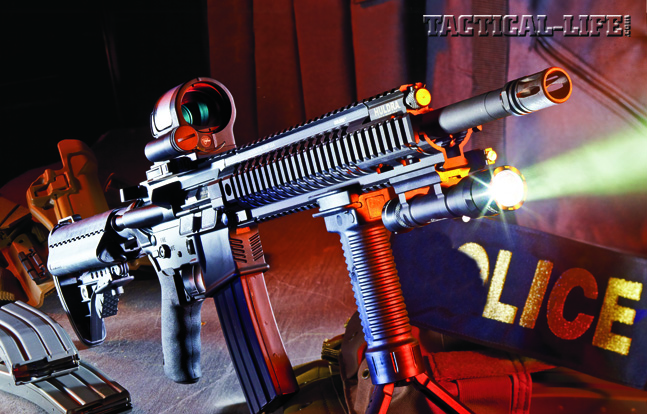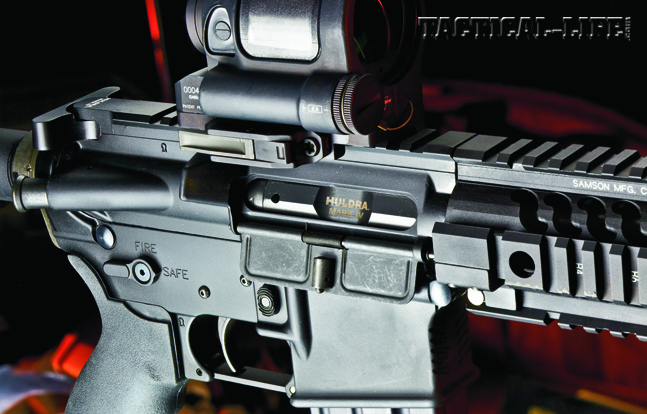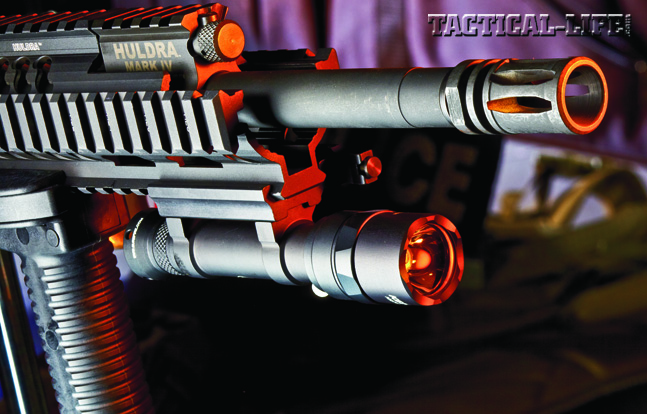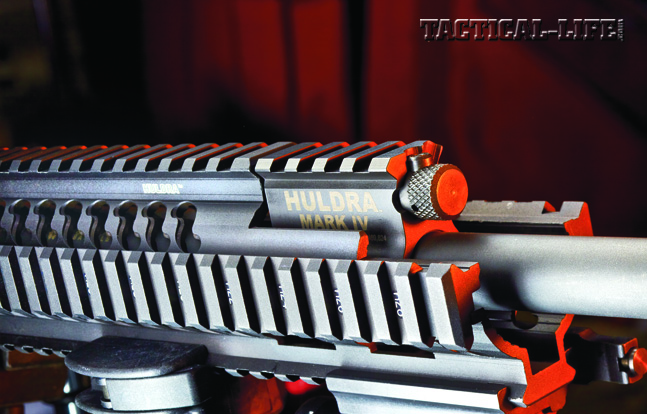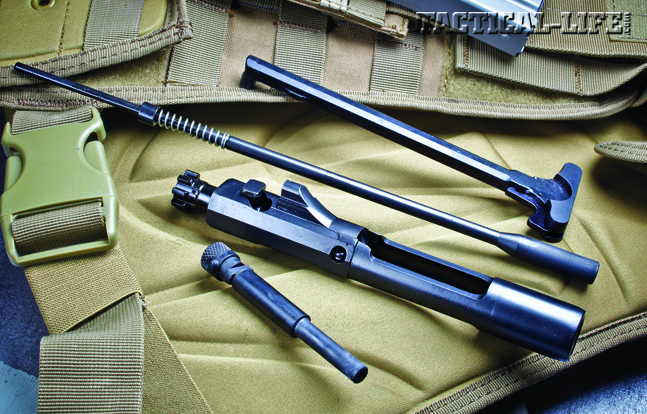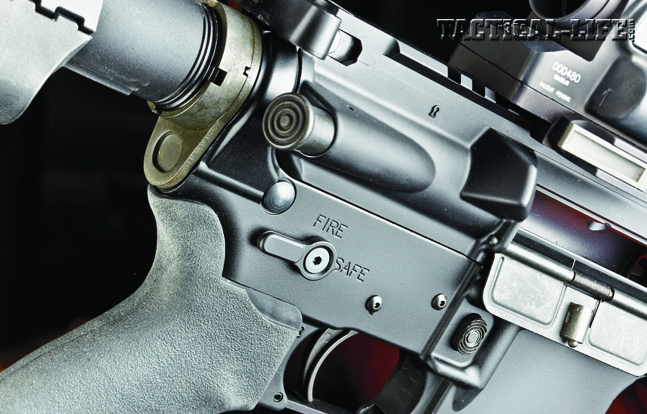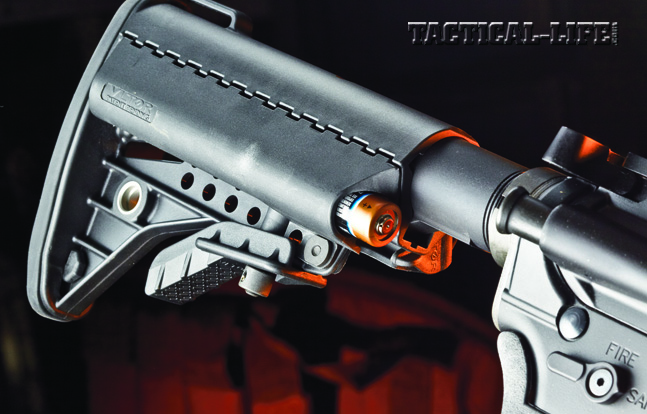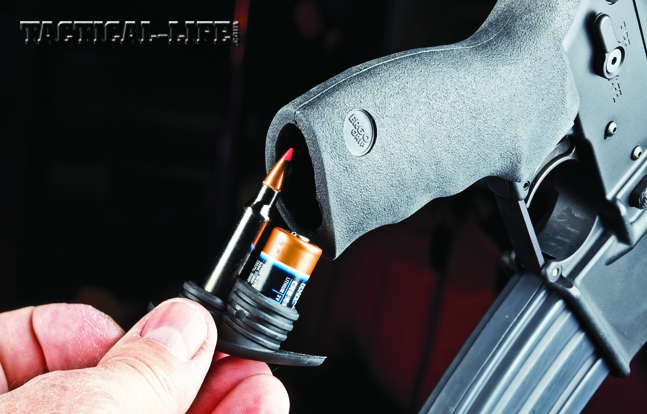My first question after accepting this assignment: “Where the heck did the name Huldra (pronounced “Hool-dra”) come from?” Was it a combination of the founders’ names or what? The answer is on the Huldra Arms website:
“In Norwegian folklore, the sometimes naked, mythically mysterious and tricky Huldra is a stunningly beautiful woman with long hair and a cow’s tail that lives in the forest realm of the trolls. In order to hide her tail, the Huldra can disguise herself as a typical dairymaid, wearing the clothes of a regular farm girl, although the Huldra can never hide that she is more dazzling and prettier than other girls. She has long been associated with hunting and shooting; she might be induced to blow down the barrel of a rifle, causing the rifle thereafter to never miss a shot.”
Huldra Arms’ AR-15s are proprietary products of Mills Fleet Farm stores, which is a cool factor in and of itself, harkening back to the days when most hardware and department stores, such as Sears and Montgomery Ward, also sold firearms, which were considered tools back then, just like any of the other tools that were offered for sale. Mills Fleet Farm stores are a family operation, with stores located in Minnesota, North Dakota, Wisconsin and Iowa, which tends to explain the reference to Norwegian mythology in its AR-15 line. It is a very popular enterprise in that region.
Advertisement — Continue Reading Below
Huldra rifles are manufactured exclusively by Adams Arms, and they all utilize Adams Arms’ proprietary gas piston system. In fact, no direct impingement guns are in the Huldra lineup. Adams Arms was one of the earliest producers of piston-operated guns, and it was the first manufacturer to offer a patented retrofit system to convert direct impingement guns to its gas piston system. The result is a line of rifles very appealing to the LE officer looking for a non-direct-impingement AR-platform rifle for patrol duty.
Continue Reading: Huldra Mark IV 5.56 Tactical Elite Rifle | Gun Review
Gun Details
The very first thing that stands out about any Huldra AR is the fact that they are shipped with six ASC 30-round magazines. In an era where many firearms of any type come with one or, if you are lucky, two magazines, this is a pretty incredible extra, especially considering that it does not appear to overly inflate the MSRP. Also included is a nice ballistic nylon case, which contains those magazines in the pockets.
Advertisement — Continue Reading Below
The Mark IV Tactical Elite itself is very nicely executed. Chambered for 5.56mm NATO, the Mark IV will also handle any of the lower-pressure .223 rounds available on the market. The 16-inch barrel (a 14.5-inch barrel is also available) has a 1-in-7-inch twist rate, which optimizes it for use with 62-grain or heavier loads. M4 feed ramps are used, and the barrel is of the government profile. It is made from CrMoV 4150 steel and is capped with a standard A2 flash suppressor. Both the piston system parts and the barrel have been treated with a proprietary salt-bath-nitride Meloniting process, which, according to Huldra, provides protection that is harder than chrome.
The gas piston port sits in a mid-length position rather than in the M4 Carbine position, and the barrel and piston are surrounded by a free-floated, 12-inch, quad-rail Samson handguard. The gas system is hand-adjustable to compensate for suppressor use or if the gun gets extremely dirty. The upper and lower receivers are machined from 7075-T6 aluminum forgings. The buttstock is a very nice, adjustable Vltor IMod, which not only provides a comfortable rest for your cheek, but contains battery storage compartments for the CR123s used by weapon lights or handhelds that you are carrying. The single-stage trigger is from JP Enterprises, with a 4.5-pound rated pull weight. The pistol grip is an ambidextrous model from Ergo, and it also contains a storage compartment.
The Mark IV Tactical Elite weighs 7.2 pounds overall. No sights are included with the rifle, but there are plenty of rails on which to mount them. By way of comparison, a similarly equipped rifle with the original direct gas impingement system I had on hand weighs in at 6.8 pounds. That’s not a huge weight difference, but if long-distance carry is in the rifle’s future, it is something to consider. Interestingly enough, Huldra claims the Mark IV Tactical Elite is capable of 1-MOA accuracy at 100 meters. This is the quality of the rifle I was most interested in—its accuracy. Could it be used as a mid-range law enforcement countersniping weapon, or would the gas piston moving above the barrel reduce its accuracy enough to preclude that?
Advertisement — Continue Reading Below
Continue Reading: Huldra Mark IV 5.56 Tactical Elite Rifle | Gun Review
Range Time
In order to find out, I used American Rifle scope rings to mount a countersniper- capable Vortex Viper PST 4-16×60 variable scope with an illuminated reticle. American Rifle’s 7075 aluminum rings feature recoil-proof gripping without marring the scope tube finish. As I can be a clutz with tools, this is an excellent feature. While the Vortex fit on the continuous Picatinny top rail, the diameter of the forward objective didn’t leave enough clearance to mount the protective lens caps that came with the scope. To solve that issue, I mounted the scope to an aluminum riser. I was still able to get a proper cheekweld on the Vltor stock, so I was good to go in terms of optics.
In order to ensure that the Mark IV would still be handy enough for CQB (I would use a lower-powered optic for the dual function), I mounted a Grip Pod vertical foregrip. Grip Pod foregrips contain two legs that are released with the push of a button, giving the user an instant bipod. This system has been popular with the military for some time now. While the Grip Pod legs can’t be adjusted for cant on uneven terrain like a dedicated bipod, I wanted to test the Huldra under the conditions that it might be used afield.
Advertisement — Continue Reading Below
I headed out for the range with four different 5.56mm/.223 loads and started with the chronographing work. One of the loads I brought along (but did not chronograph) was some actual 55-grain FMJ 5.56mm NATO ammunition. In the interests of testing as broad a range of loadings as possible with the Huldra rifle, I wanted to include these as well as some heavier-weight loads to see about the gun’s performance. Just to see where we stood, I started out by firing twenty 55-grain rounds through the Huldra Arms Mark IV Tactical Elite and found that the rifle ran just fine. I was off to a good start.
After chronographing my chosen loads to measure their velocities out of the 16-inch barrel, it was time to test the accuracy of each of the heavier-weight loads. Shooting prone off a mat at 100 yards, I found that the claim of 1-MOA accuracy capability was correct with one of the loads. My position with the Grip Pod was comfortable, and the rifle lined up perfectly. I did have to increase the length of pull of the stock for shooting prone—normally I keep M4-type stocks fully collapsed when using them for entry or patrol duties. While the JP Enterprises trigger pull wasn’t quite as light as some found on LE bolt-action countersniping guns, it was crisp and aided in accurate shooting. I didn’t really notice any difference between firing the piston-operated Huldra or a standard direct impingement gun. It was very smooth in operation.
Of the three loads tested—Wilson Combat 77-grain HPBT Match rounds, Winchester Ranger 64-grain Power-Points and Winchester Ranger 68-grain Match ammo—the best group came from the Winchester Power-Point rounds. My best group measured 1 inch during the testing of this load. Wilson Combat’s ammo ran about 1.5 inches, while the Winchester 68-grain Match ammo gave me a 2.5-inch group. Undoubtedly, had I tested the Mark IV Tactical Elite with my shooting glove or sandbags from a bench, I could have tightened the groups even more. This is definitely a piston-operated gun that can shoot just as accurately as a direct-impingement rifle, if not more so.
Advertisement — Continue Reading Below
Continue Reading: Huldra Mark IV 5.56 Tactical Elite Rifle | Gun Review
Final Thoughts
Throughout the test, which included some rapid-fire strings, the Huldra Mark IV Tactical Elite rifle proved to be absolutely reliable right out of the box. I didn’t lubricate the gun prior to firing. The action stayed absolutely spotless. A good way of thinking about the Huldra’s piston system is that it makes the rifle sort of like a self-cleaning oven that shoots.
If I were going to purchase a Huldra rifle strictly for patrol or entry duties, I would likely purchase the Mark IV Tactical Evo model. It is 0.6 pounds lighter than the Tactical Elite. While the barrel length is listed as 14.5 inches in length, it is actually a full 16 inches with the permanently affixed flash suppressor. Further, it has the traditional single-stage military-style trigger, which I would favor in developing situations. If I wanted a piston-driven rifle from Huldra Arms for mid-range precision duties, or for the capability of being converted for entry use in a pinch, I would choose the Mark IV Tactical Elite. And its MSRP is a reasonable $1,549.99. For more information, visit huldraarms.com or call 218-829-3521.
Advertisement — Continue Reading Below
